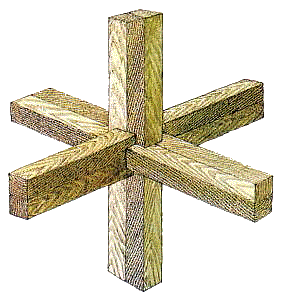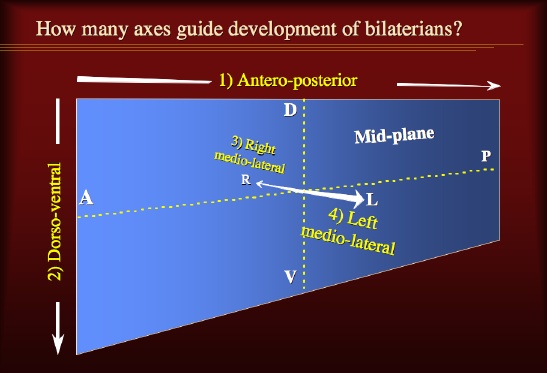
("A slightly different interlocking wood puzzle" by M. Anno) |
Bilateral Symmetry:
|

("A slightly different interlocking wood puzzle" by M. Anno) |
Bilateral Symmetry:
|
Unlike virtually all other aspects of form, symmetry is not easily 'broken' by natural selection. The most compelling evidence comes from experiments with the fruit fly, Drosophila. In sharp contrast to other traits, where laboratory selection experiments invariably yield a change in form, experiments selecting for right- or left-sidedness in eye size (1), eye facet number (2), wing-folding behavior (left over right) (3), or thoracic bristle number (4) yield no response at all! Clearly, deviations from symmetry (in a particular direction) lack a genetic basis . . . at least in Drosophila.
A moment's reflection on conventional models of development offers a clue about why symmetry is different. For structures to develop in their proper positions as eggs differentiate into embryos, cells require information about where they are.

Contrary to conventional wisdom, four axes likely provide the 'coordinate system' by which cells recognize their location:
With this information, however, a cell cannot tell whether it lies on the right or the left side of the midplane. It only knows how far it is from the head end, from the top side, and from the midplane. Therefore bilateral symmetry may simply be a default: the absence of any symmetry-breaking information. For the left side to diverge from the right developmentally, additional positional information is required.
How symmetry is 'broken', during the development of asymmetrical structures in organisms that are otherwise bilaterally symmetrical, remains a deeply puzzling question in most cases. For some evolutionary perspectives see:
Back to Asymmetry Page
A.R. Palmer
Home Page
Wood-puzzle image copyright (c) 1986 Mitsumasa Anno.
Original material on this page copyright (c) 1998-2010 by A. Richard Palmer. All rights reserved.
(revised Apr. 4, 2010)